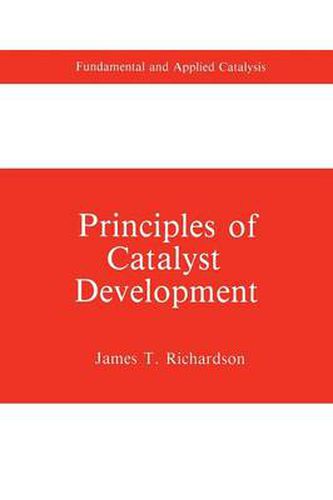Readings Newsletter
Become a Readings Member to make your shopping experience even easier.
Sign in or sign up for free!
You’re not far away from qualifying for FREE standard shipping within Australia
You’ve qualified for FREE standard shipping within Australia
The cart is loading…






This title is printed to order. This book may have been self-published. If so, we cannot guarantee the quality of the content. In the main most books will have gone through the editing process however some may not. We therefore suggest that you be aware of this before ordering this book. If in doubt check either the author or publisher’s details as we are unable to accept any returns unless they are faulty. Please contact us if you have any questions.
Successful industrial heterogeneous catalysts fulfill several key require ments: in addition to high catalytic activity for the desired reaction, with high selectivity where appropriate, they also have an acceptable commercial life and are rugged enough for transportation and charging into plant reactors. Additional requirements include the need to come online smoothly in a short time and reproducible manufacturing procedures that involve convenient processes at acceptable cost. The development of heterogeneous catalysts that meet these (often mutually exclusive) demands is far from straightforward, and in addition much of the actual manufacturing tech nology is kept secret for commercial reasons-thus there is no modern text that deals with the whole of this important subject. Principles of Catalyst Development, which deals comprehensively with the design, development, and manufacture of practical heterogeneous catalysts, is therefore especially valuable in meeting the long-standing needs of both industrialists and academics. As one who has worked extensively on a variety of catalyst development problems in both industry and academia, James T. Richardson is well placed to write an authoritative book covering both the theory and the practice of catalyst development. Much of the material contained in this book had its origin in a series of widely acclaimed lectures, attended mainly by industrial researchers, given over many years in the United States and Europe. All those in industry who work with catalysts, both beginners and those of considerable experience, should find this volume an essential guide.
$9.00 standard shipping within Australia
FREE standard shipping within Australia for orders over $100.00
Express & International shipping calculated at checkout
This title is printed to order. This book may have been self-published. If so, we cannot guarantee the quality of the content. In the main most books will have gone through the editing process however some may not. We therefore suggest that you be aware of this before ordering this book. If in doubt check either the author or publisher’s details as we are unable to accept any returns unless they are faulty. Please contact us if you have any questions.
Successful industrial heterogeneous catalysts fulfill several key require ments: in addition to high catalytic activity for the desired reaction, with high selectivity where appropriate, they also have an acceptable commercial life and are rugged enough for transportation and charging into plant reactors. Additional requirements include the need to come online smoothly in a short time and reproducible manufacturing procedures that involve convenient processes at acceptable cost. The development of heterogeneous catalysts that meet these (often mutually exclusive) demands is far from straightforward, and in addition much of the actual manufacturing tech nology is kept secret for commercial reasons-thus there is no modern text that deals with the whole of this important subject. Principles of Catalyst Development, which deals comprehensively with the design, development, and manufacture of practical heterogeneous catalysts, is therefore especially valuable in meeting the long-standing needs of both industrialists and academics. As one who has worked extensively on a variety of catalyst development problems in both industry and academia, James T. Richardson is well placed to write an authoritative book covering both the theory and the practice of catalyst development. Much of the material contained in this book had its origin in a series of widely acclaimed lectures, attended mainly by industrial researchers, given over many years in the United States and Europe. All those in industry who work with catalysts, both beginners and those of considerable experience, should find this volume an essential guide.